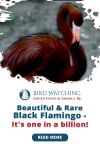
What’s This Post About?
Flamingos are the show-stoppers of the avian universe, with their long legs, curved beaks, and vivid pink hue. It is not a bird that will fly into your yard, which is why people go to zoos and natural parks to see them. Flamingos may be found in flocks in Florida, Central and South America, and a few locations in Africa.
It is their appearance that makes them distinct from the rest of the bird community. We know that the flamingos get their color from the food they consume. Does this mean that a change of diet can result in different pigments? This theory does raise the chances of green flamingoes being real.
Green flamingos are just a rumor. The green color hypotheses appeals to people because flamingos eat many green-blue algae, which according to people, could turn them green. This, however, is not the case. However, you may come across a white or a black flamingo, but those are also very rare.

What Causes A Color Change In Flamingo?
Flamingos progressively turn pink since their diet consists nearly entirely of beta carotene-rich sources.
Have you ever questioned why some flamingos are pink while others are orange? Flamingos consume algae and small shellfish high in carotenoids, which is why they are mostly pink or orange in color. They would lose their bright hue if they decided to eat a different diet.

Blue-green algae, which, unlike their name, are red or orange due to a substance called beta carotene, abound in the wetland environments they inhabit. This compound contains carotenoid— a red-orange pigment also found in carrots, sweet potatoes, and spinach.
Enzymes break down the beta carotene in the Flamingo’s digestive tract after it is consumed. Then the red-orange pigments are deposited by the fat in its liver. As the Flamingo matures, these lipids are deposited in its feathers and skin.
DID YOU KNOW?
Carotenoids are responsible for the orange hue of several foods, such as carrots? Your body and even your eyes would turn orange if you just ate carrots.
Are Green Flamingos Real?

Despite stories of green flamingos on the web, there is no proof that they are anything more than a myth. Flamingos are one of the most well-known examples of birds that receive their pink color from the food they consume. Believing that they will also turn green if fed green-colored food is incorrect.
Animals do not alter hue to match the color of the food they consume. Many of the algae that flamingos eat, for example, are already green or blue. Flamingos’ physiology selects solely carotenoid pigments from these algae for some reason, which is why they are pink. Flamingos can consume carotenoids and convert them into the pink hue of their feathers.
Flamingos devour the algae as well as the Astaxanthin-containing animals, like shrimp. Flamingos are skilled at extracting Astaxanthin from food and converting it to Canthaxanthin, a pink coloring.
On the other hand, Flamingos are unable to absorb any known blue or green pigments from their diet and convert them into blue or green feather hues.
Will The Flamingo Always Be Pink?

Flamingos will almost always be pink; however, a range of pink shades may be found. While the news of green or blue flamingoes is primarily just a hoax, if you are lucky, you may be able to find a black or white Flamingo. These are extremely rare, and their color is courtesy of a specific genetic effect.
Range of Pink

The pink coloration varies due to differences in carotenoid levels in algae and crustaceans across the globe. Flamingo populations in the Caribbean are frequently brilliant red or orange, while those in dry regions are dull pink. The pink feathers would molt away if there weren’t enough beta carotene in the diet, and new lighter feathers would develop in their place.
Black Flamingo
However, a rare black flamingo has been spotted in Cyprus and Israel. It is still unknown if it was the same bird sighted twice. Regardless, it’s considered to have melanism, a pigment disorder in which the body produces too much melanin, turning it black.
White Flamingo

Similarly, flamingos can also be white. There are multiple reasons why this can happen. Due to a genetic effect, the Flamingo might have albinism which may cause the entire body to be white.
They can also lose some coloration due to a lack of proper diet. The most common reason, however, is you might have just encountered a baby flamingo. Flamingos are born greyish white and then develop coloration as they mature.
Keep Reading!
Contrary to what you may have heard, green flamingoes do not exist. It is based on the half misunderstood concept of how the bird gets its color from its diet.
While that is true, it does not apply to every color. For example, you may find black or white flamingos, but that is also due to genetic defects and not food consumption and an occurrence that is extremely rare.
Now that you know flamingos can only be pink or white or black in rare scenarios, read about what colors hummingbirds can be ; people believe that they can change colors.
Do Hummingbirds Change Colors? We Have Some Cool Footage
It is often wondered among bird lovers whether hummingbirds change colors or not? To find out more, read through the post!

By David A. Swanson
Bird Watching USA
My name is David and I'm the the founder of Bird Watching USA! I started Bird Watching with My father-in-law many years ago, and I've become an addict to watching these beautiful creatures. I've learnt so much over about bird watching over the years that I want to share with the world everything I know about them!

David A. Swanson
Bird Watching USA
My name is David and I'm the the founder of Bird Watching USA! I started Bird Watching with My father-in-law many years ago, and I've become an addict to watching these beautiful creatures. I've learnt so much over about bird watching over the years that I want to share with the world everything I know about them!









